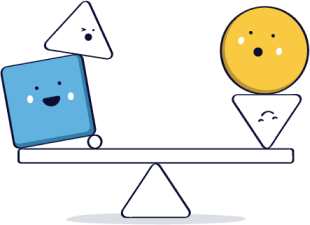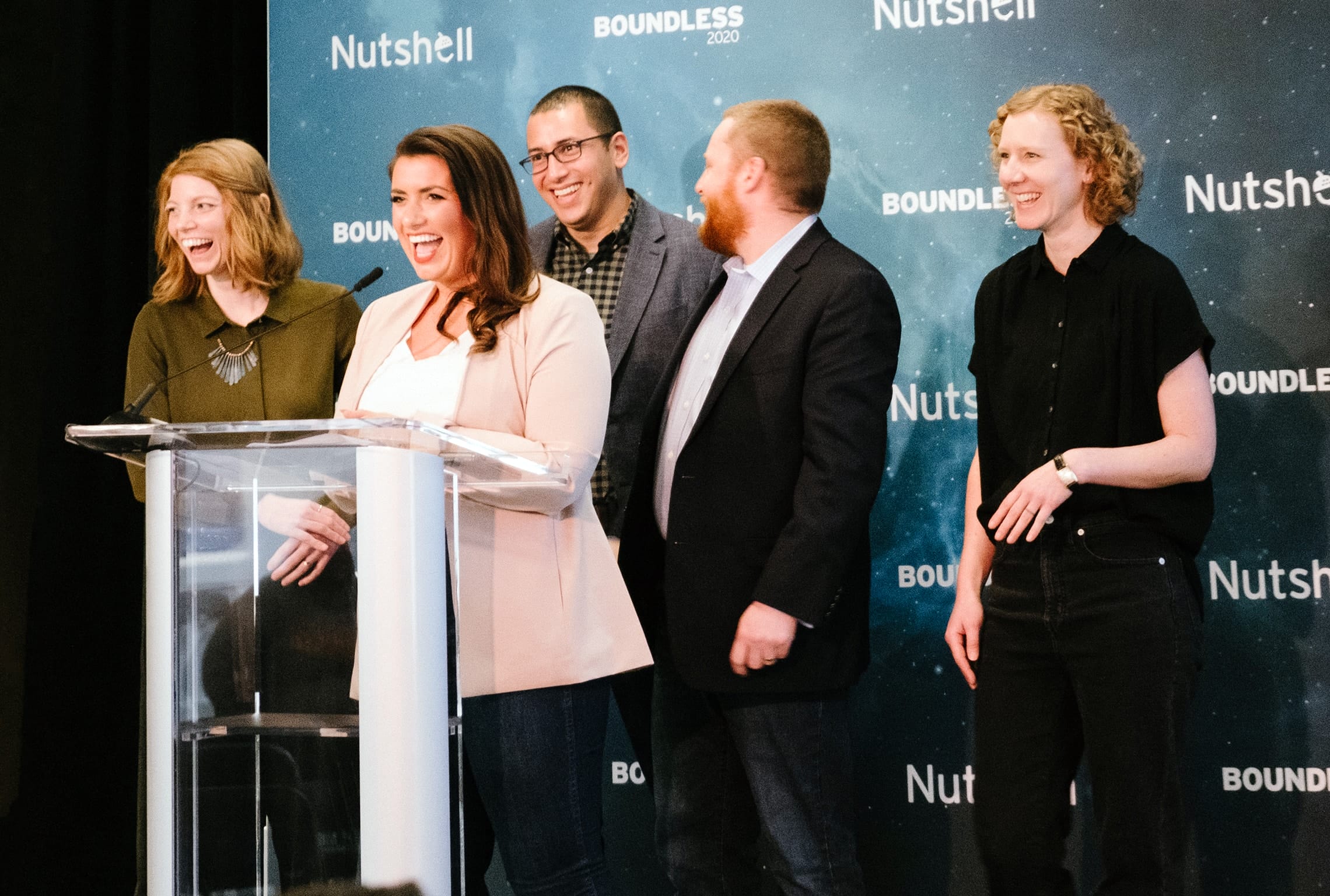
Featuring live presentations from some of the brightest minds in sales, marketing, and customer retention, the event was a massive step forward from the first BOUNDLESS show back in February 2019, both in terms of production value and attendance.
BOUNDLESS 2020 also featured some new elements—including sponsorships and an awards ceremony—which gave the event a big-show feel, even if they created some additional headaches.
Here’s the story of how the Nutshell team put BOUNDLESS 2020 together, and what we learned while trying to take BOUNDLESS from a humble one-off event to one of the greatest sales and marketing virtual conferences in the world.

BEN GOLDSTEIN,
HEAD OF CONTENT AND COMMUNICATIONS
“I was the talent booker for BOUNDLESS 2020, securing all the event’s speakers and helping them plan their presentations. I also served as head writer, assembling the live script that Kristen followed as emcee, drafting the interview questions for our Q&A sessions, and writing the majority of promotional content such as emails and social media messages.”

REBEKKA KUHN,
BRAND & VISUAL DESIGNER FOR GROWTH
“My job was to design a logo and visual identity for the event that could be carried through to every piece of content. I also designed and produced all the emails, social media assets, on-screen slides, and website content that registrants saw over time. I even got to select the trophies we awarded! Finally, I worked with our video crew to produce a streamlined show that looked and sounded awesome.”
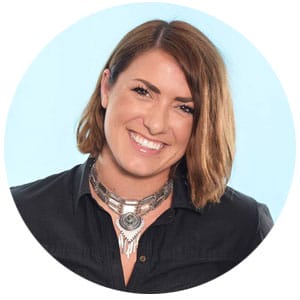
KRISTEN GRAY,
CUSTOMER SUCCESS MANAGER
“I was the event emcee and had the honor of presenting the event to thousands of online viewers, and interviewing some of the most prominent thought leaders in sales, service, and customer success. I contributed to our sponsorship efforts in the lead-up to the event, reaching out to companies who might be interested in getting their brand in front of the BOUNDLESS audience, and I was also featured as one of the BOUNDLESS 2020 aftershow speakers.”

KATHERINE MAYS,
HEAD OF CUSTOMER EXPERIENCE
“My role was mainly facilitator/coordinator, making sure that all the moving parts were happening when they needed to happen, and that the team had the resources they needed. I assisted with the overall vision of the event, and managed our Trello board and meetings. More tangibly, I had a hand in sponsorship planning and outreach, the logistics and organization of the in-person event, and internal advocacy and promotion. I also tried hard to keep the whole team inspired and to keep our spirits high!”

JACK VIRAG,
CONTENT MARKETING ASSOCIATE
“I was the chat moderator during the event. It was my job to monitor our live chat and social media for audience questions and submit them to our presenters in our top-secret behind-the-scenes Slack channel. I also handled social media publishing during the event, posting fresh quotes and takeaways to Nutshell’s Twitter and LinkedIn channels during each session.”
BEN GOLDSTEIN: The general feeling after our first BOUNDLESS event was “Damn, we actually pulled it off.” There were definitely some shaky moments that we could chalk up to lack of experience, but overall, we were all really proud of how the 2019 show turned out. I remember Shane [Bliemaster, Nutshell’s former VP of Marketing] getting in touch with us after the event and saying, “Do you know how legit this makes you look?” That was really gratifying. As a content marketer, BOUNDLESS was the sort of thing I dreamed of doing at Nutshell when I first started working here—big initiatives that raised our profile. I honestly couldn’t wait to do it again.
REBEKKA KUHN: Without a doubt, I wanted to improve the production value for 2020. In our first year of BOUNDLESS, we were DIY’ing it with a webcam in a conference room. That led to some audio and screen share complications that really slowed the tempo of the event, so I wanted to solve those problems the next time around.
I also wanted to find ways to drive more live viewership on the day of the event. Of course, we send the session recordings to all the registrants after the event, but watching the event live allows you to feel like you’re part of the larger sales and marketing communities. A more active live chat would drive better and more relevant questions to include during the speaker Q&As, and keep viewers engaged throughout the entire day of events.
KRISTEN GRAY: Following BOUNDLESS 2019, I wanted to contribute to the overall polish and presentation of the event, and create tighter communication between our BOUNDLESS chat mediators and live speakers. As the host, I wanted to be able to react more quickly to our audience’s engagement with the sessions and advocate for our viewers so their voices could be heard.
KATHERINE MAYS: The thing I wanted the most for 2020 was to make it bigger—that could have been a bigger audience, more well-known speakers, more content overall, a better set, more involvement of more stakeholders. I was really impressed by what we accomplished in 2019, and I wanted the next one to impress everyone else.
Because there’s nothing quite like the energy of an in-person conference, I also wanted to find some way to have a live audience in the room with the broadcasters, even if it was small. And of course I wanted to improve on the production quality, rather than hacking something together at the last minute.
BEN GOLDSTEIN: We spent a little over $11,000 putting BOUNDLESS 2019 together. The biggest chunks of that were the $4,500 we spent on speaker fees, and the $3,000 or so we spent printing t-shirts, stickers, and Nutshell stocking caps and sending them to early registrants. Outside of that, it was a few hundred here and there on stuff like giveaway prizes and the Gleam subscription we used to manage contest entries and encourage social sharing.
We figured we could double the budget for BOUNDLESS 2020, put on a show that was twice as good, and get twice as many people to register. So, if a little over 900 people registered for BOUNDLESS 2019, we wanted at least 2,000 for BOUNDLESS 2020. That seemed reasonable enough. In the end, BOUNDLESS 2020 nearly quadrupled the previous year’s registration total and looked 10 times more polished, in my opinion. But we had to go beyond our budget to make that happen.
KATHERINE MAYS: To drive all our planning efforts for BOUNDLESS 2020, it was important to have a guiding principle—a theme. Something that we could share with speakers and attendees in an elevator pitch, which could encompass many topics around driving revenue growth for small businesses. It needed to be inspirational and aspirational, to set the tone for ourselves and anyone else involved in the event. Most of all, it needed to fit our name and identity: BOUNDLESS!
We had all these branding ideas for imagery involving rocket ships and charts trending upwards. I think landing on the theme of “Above and Beyond” was a pivotal turning point in our planning for 2020, and I remember feeling elated in the same way as when you finish building the border of a puzzle or when you finally choose a dinner recipe and have all the ingredients on hand.
To us, “Above and Beyond” meant creating exceptional customer experiences at every stage of the sales funnel, and that was what we wanted most of this year’s sessions to focus on. But it was a broad enough theme that it could easily fit a wide range of speakers and topics, while also carrying some excitement on its own.
KRISTEN GRAY: One thing that contributed to the initial success of BOUNDLESS is that the core team has vastly different skill sets. I can’t imagine switching hats with any of them, and the respect I have for the other members of this team is next level.
This also made it an interesting challenge to agree on what direction we should take the next event. The product of those important, revealing conversations was that we all wanted to help our audience members elevate the way they do their business. We are not an events team, we are a group of passionate professionals that value thought leadership in our respective spaces. We are brought together by a software that helps businesses improve the way they approach marketing, sales, and customer success, and it made sense to use the same “through the funnel” framework in planning the sessions for BOUNDLESS 2020.
BEN GOLDSTEIN: The first official production meeting for BOUNDLESS 2020 was scheduled for May 31st, 2019. The goal was to discuss the scope of the event—how far we wanted to stretch beyond BOUNDLESS 2019, in other words—and also figure out what we needed to lock down in the short term, like the date and the venue.
KATHERINE MAYS: I started with a meeting notes document that we updated during every meeting throughout the year, and I created a Trello board with categories of everything we had done the previous year, making some tweaks based on things we wanted to do differently this time. The Trello board was our repository for everything: links to meeting notes, the budget sheet, the speaker outreach list, the sponsor outreach list, and visual assets like speaker headshots and logos. It’s also where we stored initial decisions like the date and our registration goal, which were later moved to a big white board.
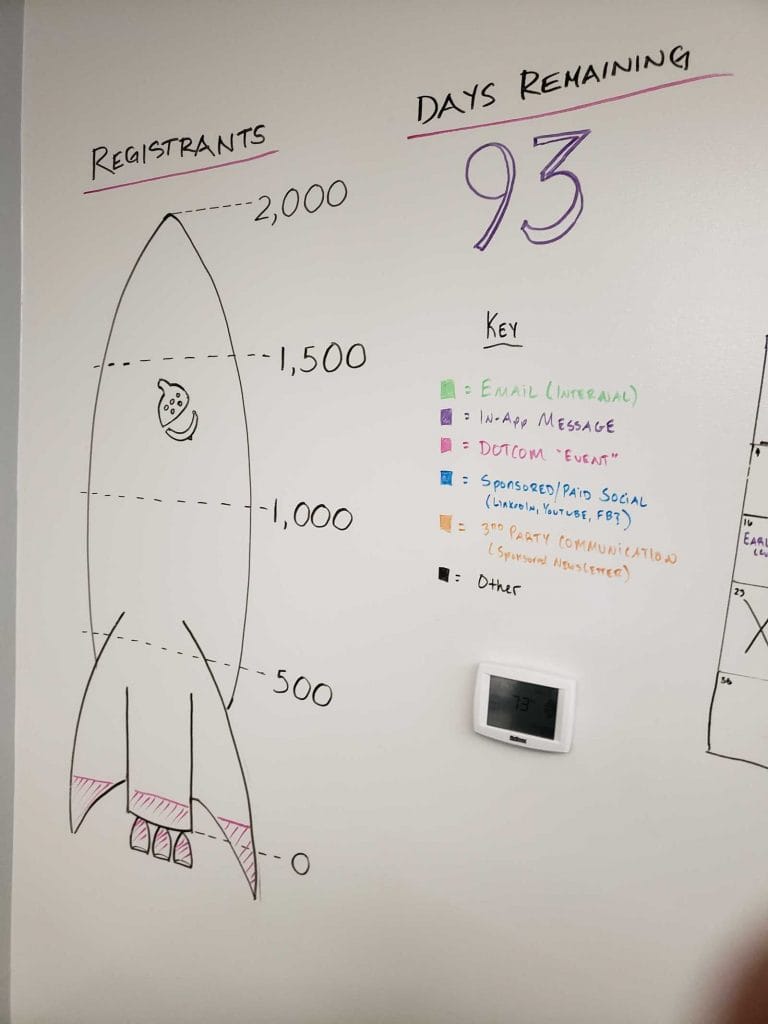
We began tracking all tasks and due dates on this board, and it was our go-to source for updates, topics to discuss in meetings, and understanding who was responsible for what. While people made updates to the board along the way, it was helpful to have one person “in charge” of it.
KRISTEN GRAY: Our first BOUNDLESS conference took place in February 2019, and created a nice bump in sales for Q1 of that year, primarily because it gave us a good reason to promote the Nutshell brand to our marketing list in the lead-up to the event. Since the timing worked out well last time, we decided to host BOUNDLESS 2020 in Q1 once again. So, we looked at our PTO calendar and chose a date when we knew all the core members would be there. We are a small planning team, and each person plays an irreplaceable role!
BEN GOLDSTEIN: The date we landed on for BOUNDLESS 2020 was Friday, March 6th. I just did the math, and there were 281 days between our first BOUNDLESS 2020 planning meeting and the date of the show. And man, did those 281 days fly by.
KATHERINE MAYS: The first thing I focused on was finding some well-known organizations that were good fits with the Nutshell culture and brand, that we could source for speakers or sponsorships. Aligning ourselves with recognizable names felt like a good way to build credibility.
I began soliciting our colleagues for household names they were excited about, that we could reach out to in our speaker search. But after some consideration, many of the “household names” were actually bad fits in terms of alignment with Nutshell’s message and values. After all, we’re here to help small and medium-sized businesses grow. Most large companies and national corporations have much different goals.
Still, I think this step was important because it helped us solidify our own identity and define what we wanted from BOUNDLESS 2020. Piggybacking on the success of other corporations that didn’t align with our goals did not feel like the right call, and ultimately we scrapped most of the list.
BEN GOLDSTEIN: One of our meetings in early July involved a long brainstorm session on “dream speakers.” In addition to the tactical sessions on sales, marketing, and customer success that we wanted to include, we also wanted at least one marquee name that would give the event immediate credibility. Big-name business authors like Cal Newport, Kim Scott, and Daniel Pink were suggested. The first two speakers I suggested were author and comedian Sarah Cooper and Spartan Race founder Joe De Sena. I remember Katherine suggesting Alan Alda, who has apparently devoted his recent life to improving the way human beings communicate with each other.
After that meeting, I immediately got to work sending emails to speaking agents and publicists, explaining our event and how we’d love to get so-and-so involved as a featured speaker at BOUNDLESS 2020. Almost everyone replied, and many were even interested in appearing. The problem was, these big-name speakers came with big price tags, usually in the $20,000-$35,000 range, which would have swallowed our entire budget. I won’t tell you how much Alan Alda’s asking price was, but damn, nice work if you can get it.
So, we might not have had the money for a “celebrity” speaker, but between the budget we did have on hand and the size of the audience we were expecting, we had no problem attracting some truly world-class sales, marketing, and support experts. The first marquee name we locked down was Jeffrey Gitomer, who’s a legend in the sales world, and who put together some really wonderful video and email promotions for the event that drove a big chunk of our registrations.
Speakers like Dave Blake, Sujan Patel, and Jill Nelson are giants in their fields, and they all did the show for free! We also wound up getting a speaker from a “household name” brand, after all—Rob Siefker of Zappos. He didn’t do the show for free, but we were happy to pay a few grand to get him on board.
REBEKKA KUHN: The original BOUNDLESS 2019 wordmark was developed using the same typeface as Nutshell’s logo so that it would play well when paired together. For consistency from year to year, we wanted to keep the same wordmark but introduce a new look that would feel decidedly different from the previous year and visually explore the “Above and Beyond” theme for 2020. Outer space immediately came to mind as a design concept that could hold everything together.
I started playing around with the visual identity in September 2019. It wasn’t until later in October that I settled on a design that could hold up across all communications and assets over the next few months.
Next up was assembling the registration page—which included headshots and bios for the speakers, as well as the event agenda as it came together—and then connecting all of our software together to collect registrations and stay in touch with attendees before the event. The webpage held a simple Gravity Form that integrated with Constant Contact, which we used for all of our email communications.
BEN GOLDSTEIN: Once a speaker agreed to do the show and we agreed to their fee, if any, I would schedule a call with them to work out the general topic of their talk, plus whether it was going to be a solo presentation or a Q&A with a member of our team. Following this initial conversation, I would draft an official title for their session plus a two-paragraph description, and email it to them for approval. Once I got approval from the speaker, I’d send the copy to Rebekka to add it to the registration page.
Then, for the four sessions that were going to be live Q&As, I drafted about 8–12 questions apiece and assigned each interview to a member of the core team. [Former Nutshell Head of Growth] Mike Carroll had previously done a fantastic interview with Sujan Patel for a Nutshell webinar on email sales, so I put them together again; Mike was also going to host a brief Q&A with our Co-founder and CTO, Andy Fowler. I knew Kristen was a huge fan of ClientSuccess Founder and CEO Dave Blake, so I offered her the interviewee spot for that one. Then, I basically flipped a coin and had Katherine interview Christine Volden of Soulful Selling while I would interview Jill Nelson of Ruby Receptionists.
KATHERINE MAYS: We broadcast BOUNDLESS 2019 out of a conference room in our office, which created some operational challenges; plus, it just looked like we were broadcasting it out of a conference room. So how could we take a step-up for 2020? I did some research on available event spaces and auditoriums in downtown Ann Arbor before realizing that the easiest solution was right in front of us.
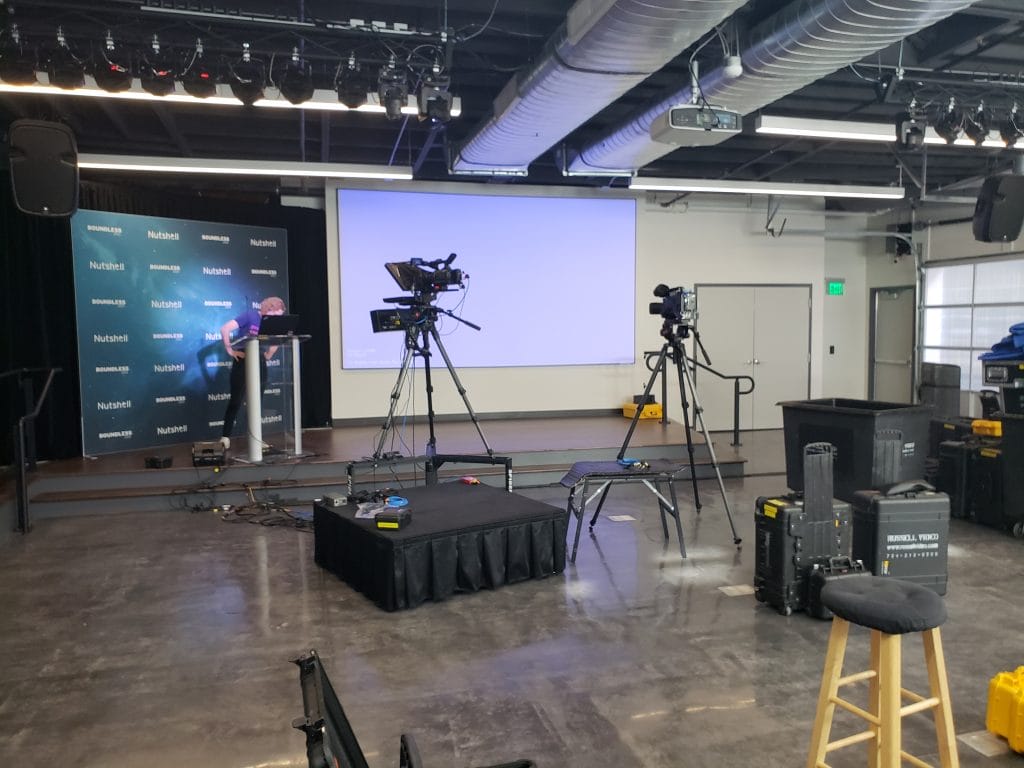
Nutshell has been based out of the Cahoots co-working space in downtown Ann Arbor since the end of 2017, and we decided that holding it in the Cahoots event space would be ideal, even if we didn’t have a live audience. It gave us the opportunity to have great lighting, a podium and backdrop, the flexibility to make the event larger or smaller, and a location outside of a cramped conference room. We were very lucky to have access to an on-site space that is purpose-built for live presentations, and for a virtual event, reliable hard-wired Internet access is a must!
KRISTEN GRAY: The first BOUNDLESS event was totally sponsor-free, but with our expenses more than doubling for the 2020 show, we discussed attracting outside sponsorships to offset some of the cost. Still, whatever sponsors we brought on had to be relevant to our audience. The early inspiration for BOUNDLESS came during a van ride to a team off-site a few years ago, when Katherine suggested creating a “Customer Appreciation Day,” and even though the event has evolved into something much larger, serving our customers has always been one of primary goals.
I started having conversations in November with the team about what kind of companies our audience would benefit from learning about. Selling sponsorship packages was something I had never done before, but I welcomed the opportunity to share my excitement about BOUNDLESS with other companies in the space, and being able to lean on the understanding of my Nutshell customers’ needs was helpful in deciding who I should reach out to and how to prioritize that outreach.
BEN GOLDSTEIN: I drafted a rate sheet that Kristen and Katherine could leverage in their sponsorship outreach, promising potential sponsors “significant, sustained visibility across Nutshell’s customer base and subscriber channels leading up to the event and during the broadcast itself.” (See the rate sheet here.)
So for $1,000, you could get your logo on the registration page and in all the promotional emails, and we’d tag you in some social media messages. For $2,500, we’d do all those things plus send out a dedicated pre-show email to our list that was only about your brand, and we’d post links to whatever you wanted in the live chat. And for $7,500, we’d share the registrant list with you and let you run a commercial for your brand twice during the event. Nobody bit on that one, but it was worth a shot.
The mistake I made with the rate sheet was not including any deadlines. At a certain point, we were just too time-crunched to deliver on certain items that were being offered, which created problems for Kristen and Katherine.
KRISTEN GRAY: The biggest challenge during these sponsorship outreach conversations was finding the right point of contact at these organizations. I learned quickly that my existing connections with professionals in our network led to much more interesting conversations than the cold emails I was sending to bigger companies.
I also learned that I needed way more lead time in order to secure the right point of contact, facilitate those conversations, come to a mutual agreement about their level of involvement, and collect payment. When conversations went long, I had to make some quick adjustments to our offers so that we could be sure to deliver on what we had promised in our sponsorship packages. Certain things like the number of sponsor mentions in our pre-event emails to registrants became limited due to the number of days left in our promotional cadence.
REBEKKA KUHN: On the recommendation of our videographer Logan Braun, we hired a local event production crew called Russell Video to produce the broadcast. I was a little hesitant about bringing them on, because their estimate ate up about half of our original budget, but what they were able to do for the cost was insane.
They had a five-person team working for two days straight to set up and run the technical backend of the event, helping connect our speakers to the broadcast then getting them on and off screen when appropriate, while ensuring that Kristen and our other Q&A hosts could see who they were talking to, and making everything look TV-quality. They killed it. It was a big step up from the community theater vibes of our 2019 show. And when they sent in their final invoice, it was $1,000 lower than their estimate.
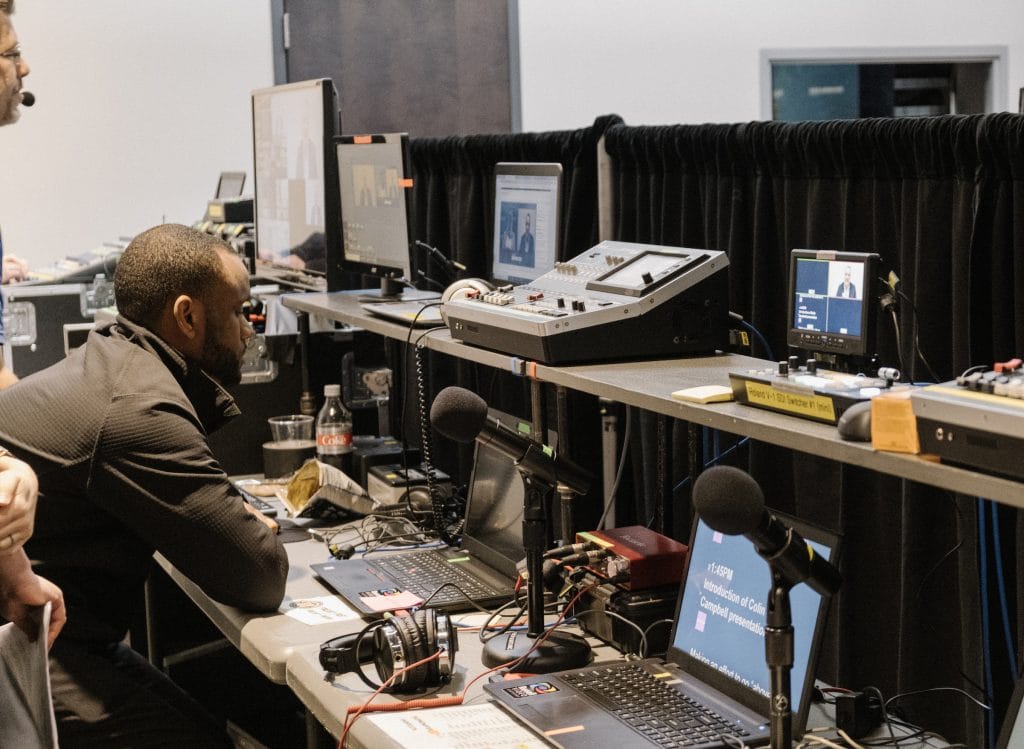
KRISTEN GRAY: During our first BOUNDLESS event, I spent a lot of time tiptoeing behind the camera and around a bunch of cords in the conference room we were shooting in to haphazardly get to my laptop and jot down questions to ask the speakers. Not only was it chaotic, but I missed out on some awesome audience participation once the Q&A sessions began. I still regret the process we had in 2019 when I think about all the great engagement I wasn’t able to bring to those follow-up conversations after each speaker’s session ended.
This year, we upgraded our process and created a private, completely dedicated Slack channel that Ben and Jack would use to immediately let me know the questions they were gathering from our live chat, social media, and our own team. I used my phone throughout the show to pull up that Slack channel and I could glance down at it when I was at the podium, which allowed me to gracefully continue the conversation with our speakers without taking too much time to stress about what came next.
This was a much better process than what we attempted in 2019, and it led to some great dialogue that could not have happened otherwise. Pro tip: make sure you turn off your display auto-lock so you maintain access to your phone the whole time without it going to sleep…and bring a phone charger!
BEN GOLDSTEIN: The other wise decision we made in terms of the emcee setup was paying extra to have a teleprompter this time around. Kristen was working off notes on her laptop screen for BOUNDLESS 2019, and she definitely made it work, but it just meant she couldn’t maintain constant eye contact with the camera, so to speak. For the record, Kristen was absolutely ready to commit all 2,500 words of my emcee script to memory. But investing in the prompter was the right call; she could worry less about the words and focus on bringing her fantastic energy to the broadcast.
Also, I wish I had thought of that display auto-lock trick myself, because I spent the second half of my interview with Jill Nelson with one finger on my phone screen, steadily tapping on the Slack window so it wouldn’t turn off.
BEN GOLDSTEIN: Officially, this year’s registration goal was 2,020. (Ha, ha.) There was absolutely no doubt in my mind that we could hit that number. We had a built-in audience from last year, plus we had a few thousand dollars more to spend on promotion.
One of the first things we did was assemble a hype video that we could use to give the registration page more excitement, feature in YouTube pre-roll ads, and leverage in any remaining conversations with potential speakers and sponsors. The biggest challenge was that we didn’t have any exciting “live” footage from last year to include, outside of a few clips of our team presenting at the podium in our conference room.
So instead, I reached out to the handful of BOUNDLESS 2020 speakers that we already had booked and asked them to share some thoughts on how companies can go “Above and Beyond” for their buyers. We leaned on the space-and-rockets visual imagery to add some drama, and the final product was pretty damn cool.
We tried all kinds of things in 2019 to convince people to register for the event. We offered BOUNDLESS t-shirts to the first 200 registrants and Nutshell stocking hats to the first 50, and we promoted a giveaway of Bluetooth speakers and iPads to randomly selected registrants. But now that the event was in its second year, all that stuff felt unnecessary, maybe even a little desperate. People were psyched about BOUNDLESS 2020 just because of the content; they didn’t need to be bribed anymore.
Still, Mike felt that we needed some kind of early registration incentive, to build up our attendee list right away. He suggested putting together an “aftershow,” where the first 250 registrants would get access to a set of pre-recorded bonus sessions, which would be sent to them directly after the live event. We promoted the aftershow in the very first BOUNDLESS 2020 announcement email that went out three months before the event, without the slightest idea of what it would actually look like or who would participate. I’m not sure how much impact the offer actually made on people signing up, but 370 people registered for the event on the first day, which was awesome. We were off to the races.
So now it was basically up to me to hustle up 3-4 additional interview subjects, convince them that being put on the BOUNDLESS 2020 second stage was actually an exciting opportunity, then prepare the interviews and find some times where Logan could record us at his studio. I gave myself a moment to grumble about the new batch of work I would have to shovel through. But the aftershow also gave us a cushion of emergency content to lean on in case our main speakers dropped out last-minute. Which happened, by the way. Honestly, the aftershow wound up saving our asses.
KRISTEN GRAY: After getting the ball rolling on several sponsorship conversations, Ben asked me to record an aftershow interview with him, which we were going to send to select BOUNDLESS registrants. I am a Customer Success Manager who is in a constant state of process iteration to best serve the customers I work with to onboard and be more successful. He gave me a platform to talk about what I am most passionate about, and it was the first time I had been interviewed on camera to talk about myself. Even a year of BOUNDLESS emcee experience and a decade of working a customer-facing role could not have prepared me for that moment! As a speaker, I had to let go of the idea of perfectionism so that I could be genuine in how I got my message across.
BEN GOLDSTEIN: One new promotional channel that we used to draw registrants for BOUNDLESS 2020 was third-party newsletters. Last fall, I’d done some research on popular email newsletters that had credibility among B2B sales professionals—Nutshell’s target buyers—and we started making small investments in a handful of them, paying to get our content featured in their email blasts. The goal was simply to get the Nutshell brand in the minds of sales pros who had never heard of us before.
Jeb Blount’s Sales Gravy newsletter quickly emerged as the clear winner. They had a list of over 300,000, their readers were really engaged, and every time we promoted a new sales resource in their newsletter, we’d get well over a thousand people clicking through, with about half of them downloading whatever we were offering at the time. At $1,200 per appearance, we were collecting new contacts at $2-3/pop, which beat every other paid marketing channel we had.
So in the run-up to BOUNDLESS 2020, we made sure to buy two appearances in the Sales Gravy newsletter, promoting the BOUNDLESS event. For our $2,400 spend we netted about 650 registrants from their list, which got us to our 2,020 registration goal way ahead of schedule.
And then of course we scheduled our own series of announcement emails that went out every couple weeks to our own list, hyping up the speaker lineup and new additions to the event, as well as a separate reminder series that went out only to registrants starting a week in advance. The only real change this year was that we added a reminder email midway through the show, letting registrants know that there’s still time to catch the afternoon sessions, and what was coming up. We’ll probably do even more of that sort of thing next year.
KATHERINE MAYS: Personally, I had some anxieties about hosting a live interview with someone I had never met before. I did a lot of research about Christine Volden, her brand, and her message, and it resonated strongly with me, which made it easier. Next time, I’ll definitely push for an introduction and conversation beforehand.
I also coordinated and handled all the invitations for our in-person audience. Waiting for people to show up, and wondering if those who’d RSVPed would actually make it out to our free event that was designed to be a virtual event was nerve wracking.
Primarily, though, I was feeling nervous for the team! We had checked all our boxes, but it was important to me to be as supportive as possible to Kristen, Rebekka, and Ben, our teammates with the most day-of responsibilities. Even when you think you’ve planned and back-up planned everything, who knows what unknown things could cause hiccups throughout the day.
I made sure that we would all be fed (there wasn’t time for a group lunch break) and our colleagues Gabe and Chris from the engineering team very considerately brought in an early bagel breakfast for us!
BEN GOLDSTEIN: One of our speakers opted to pre-record his session instead of doing it live, which seemed like an advantage at first. It meant we’d have one session where there would be no possibility of technical difficulties or an unexpected no-show. Plus, it wouldn’t cost us anything; while booking the speakers, I made it clear that we’d only pay for live appearances.
The session recording was supposed to be in my hands by the beginning of February. As long as I had it by the middle of the month, there would be no problems whatsoever. But due to some unexpected delays on the speaker’s end, he didn’t get around to recording and submitting his session until February 26th.
I couldn’t relax all month, wondering if one of our most prominent speakers was going to flake out. The whole time, his assistant was telling me, “Ben, don’t worry about it, this guy’s a pro, he never lets people down, ever.” But it was the first time I’d ever worked with him, and I was stressed about it. In the end, he came through and gave us an awesome presentation, but I had to come up with a back-up plan in case he didn’t deliver. We had Charlene DeCesare’s aftershow interview queued up to run during the live event.
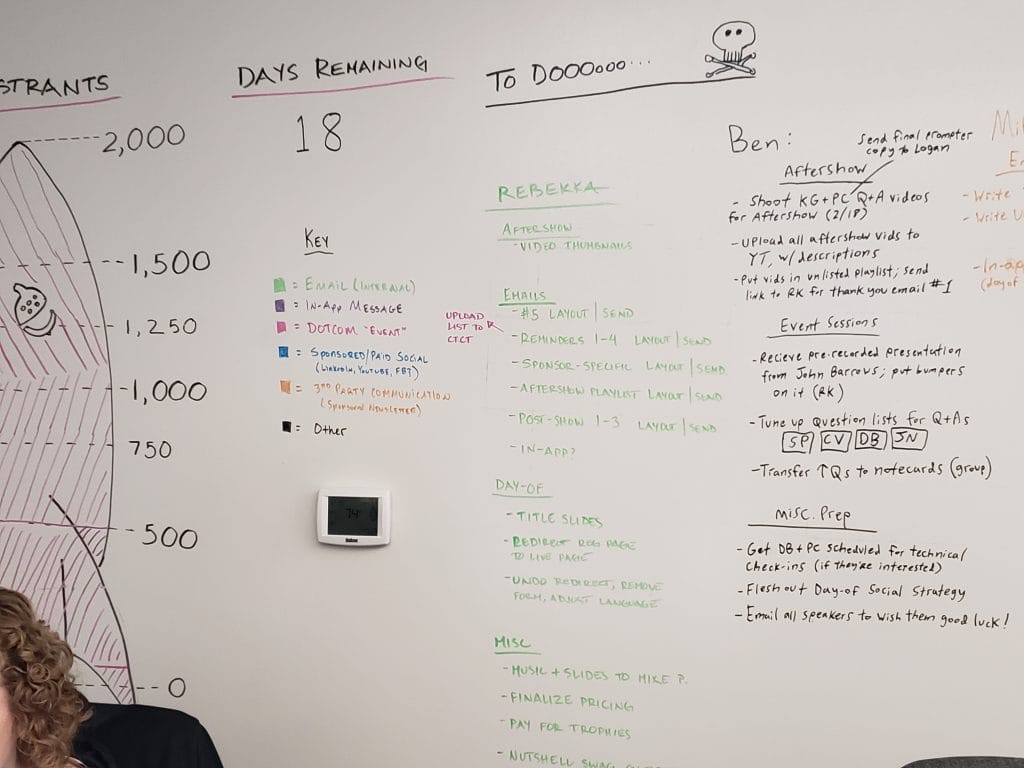
The very same day the pre-recorded session came in—eight days before showtime—I got an email from Sujan Patel saying that he had injured his shoulder, and the only time his doctor was able to see him for a pre-operation appointment would conflict with his BOUNDLESS live session. So, one crisis was averted just as another fell into my lap. Unbelievable. Sujan asked if he could switch his session with the last speaker on the lineup, but that basically meant asking Rob Siefker of Zappos if he wanted to hit the stage at 7:45am Las Vegas time, which was a non-starter as far as I was concerned. Instead, I asked Sujan if he wanted to pre-record his interview, which he agreed to.
The next thing I did was reach out to Barb Giamanco, who I had just spoken to the day before about something completely unrelated, and I asked her if she wanted to rescue us and fill in as a live interview subject at BOUNDLESS 2020. As much as I wanted to keep Sujan on the show—I was more excited for his topic than anyone else’s—airing his pre-recorded interview during the broadcast would give us two back-to-back canned interviews in the morning block, and I thought that would sap the energy of the event.
Luckily, Barb said yes, which meant Sujan would now be relegated to the aftershow. That was the plan, at least.
REBEKKA KUHN: Having already produced one BOUNDLESS, I had a good sense of how much of my time would be devoured by this event. As the solo in-house designer for the Growth team, there were certainly a lot of projects put on the back burner in the lead up to March 6th. But I had the support of the entire team so if something couldn’t get done right away, everyone understood.
BEN GOLDSTEIN: On March 3rd, Outreach announced that they were canceling Unleash 2020 amid concerns over the COVID-19 epidemic, which felt like a very bad omen. We were still hustling trying to get our event off the ground, and there was nothing stopping us from broadcasting the event virtually, but we had no idea what the rest of the month was going to look like. I’m just glad that the months of work we put into the event didn’t go up in smoke.
That same day, this tweet showed up in our feed. It upset me, because I knew how accurate it was. The lack of diversity in our speaker lineup dawned on me much too late. So much of my outreach was targeted at people I already knew of, who I had seen in previous conferences, whose work I personally related to. There was a huge blind spot when it came to voices outside of my own sphere of familiarity.
This was not unexpected criticism. The lack of diversity in conference lineups has been a running punchline in the business world for years now. Audiences expect better. I should have made speaker diversity a priority from day one. Next year, speaker booking for BOUNDLESS will be handled by a larger committee featuring a more diverse range of voices and experiences. I promise we’ll do better.
REBEKKA KUHN: To borrow some phrasing from Donald Rumsfeld, I was worried about the “unknown unknowns.” We were using Zoom to connect each speaker to the broadcast feed that attendees would see on our website, and to avoid audio and visual problems we organized a technical dry run the previous day. Each speaker had a 15-minute block where they would call in to a dedicated Zoom link and our broadcast team would work with them to make sure that we’d be able to see and hear them during the broadcast. But one of our Zoom streams that remote speakers were using to join kept getting disrupted.
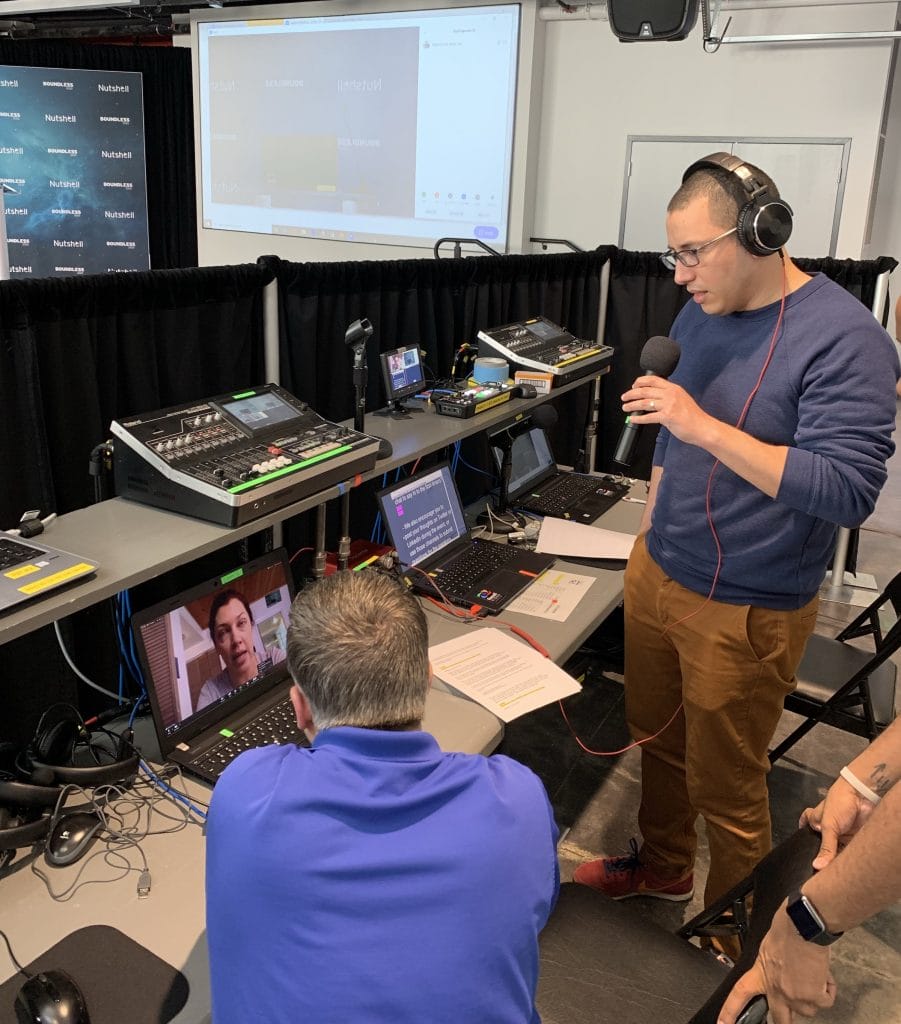
BEN GOLDSTEIN: We were using Zoom “webinars” instead of Zoom “meetings,” or maybe it was the other way around, I don’t remember. The point is, things were not proceeding as planned. We eventually sorted out the technical challenges, but since the dry-run was scheduled the day before the show, any problems we ran into had to be fixed that day. It was a very unforgiving timeline.
I think Jeffrey Gitomer was the first speaker scheduled for a technical check-in. We had trouble connecting his audio or something, and his team had to temporarily jump off to another meeting before we could get it figured out. Someone from the Russell Video crew told me, “Sorry, Jeffrey sounded kind of pissed, he was in the background yelling about how we didn’t have our acts together.” And I had to tell him, no, it’s okay, Jeffrey’s just a yeller.

BEN GOLDSTEIN: I got to the office around 8:45am that morning, and the Russell Video team was already fully set up, locked and loaded. Seriously, hire those guys if you can. I gave them a hard drive that contained two video files: the pre-recorded 45-minute interview we did with Sujan Patel, and the 20-minute aftershow interview with Charlene DeCesare. If something weird happened during the event, we’d have backup options that could fill different lengths of time.
BOUNDLESS 2020 was scheduled to start at 10am ET. We’d asked all our speakers to join the virtual broadcast 15 minutes in advance of their session time to work out any last-minute technical bugs, and Jeffrey Gitomer, total pro that he is, showed up at 9:45am on the dot. Last year we had some…uh…issues…connecting with our very first speaker. I’m not going to tell the story publicly, but anyone who knows me personally has heard it before. So we had at least cleared the low hurdle of having our first speaker show up on time. A small, but important victory.
JACK VIRAG: The live chat was a great way to keep user engagement up—especially since this was a remote event. Before BOUNDLESS officially kicked off, users took the opportunity to introduce themselves in the chat, stating their names, locations, and professions. We had viewers all over the world! That was wonderful to see.
BEN GOLDSTEIN: The live chat system that Russell Video set up was definitely a big improvement from the single-stream chaos of the previous year’s YouTube-based chat. Having separate windows for general conversation and speaker questions made things really easy for us. But we still needed to moderate it for abuse.
As soon as the event started, attendees started entering the chat, and shouting out where they were from. But then someone with the username “Pauly D” posted “CABS ARE HERE!” which was followed by “J-WOWW” and “Snooki” posting other assorted Jersey Shore catchphrases. I didn’t have time for it. I immediately banned all their IP addresses. A few minutes later, a new user named “Nicole” left a comment asking why her and all her friends were just banned from the chat. I banned her too. Not on my watch.
KATHERINE MAYS: Watching the number of people viewing the livestream climb in those first couple of hours was amazing. There’s nothing like observing something you’ve put months of work into pan out successfully, and I was feeling super proud all day of what we’d achieved. The comments that we received from attendees were all so positive, the team was able to adjust for all the scheduling issues that we encountered throughout the day, and we started receiving amazing feedback from board members and investors. It was incredible.
KRISTEN GRAY: I vividly remember this awesome moment minutes before the event started where I was looking around, and I could see every one of my team members absolutely killing it at their respective roles. We were communicating when we needed to, but otherwise each person maintained laser-focus on their areas of impact. I still get goosebumps when I remember stepping out on stage to see them running around, and I thought to myself “Kristen, you better kill this, too!”
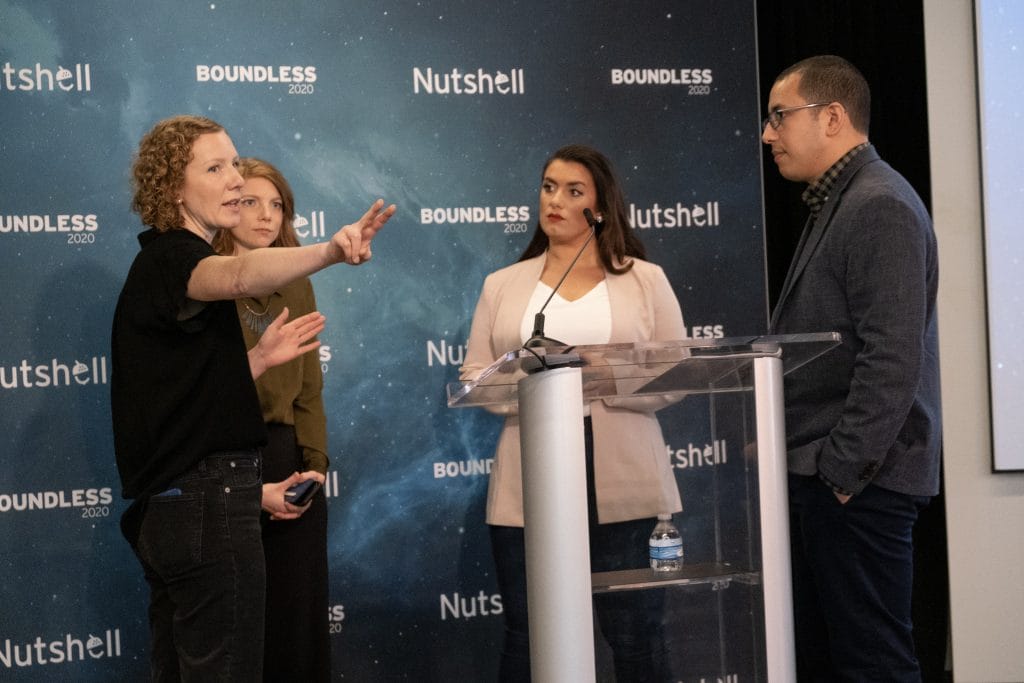
BEN GOLDSTEIN: At 11:30am, just as Mike was having a lovely conversation with Barb Giamanco, I got the following email from the event manager for one of our speakers:
“Sending an urgent message with some bad news. One of our team members is going through a personal emergency, and due to their role it affects the entire company. [SPEAKER NAME] is obviously bearing the brunt of this issue, and cannot make the live talk today.
I’m so sorry that the timing for this is bad. Given the nature of the event I think we have two options:
1. I have my team edit a webinar on the topic that can be played.
2. We have [SPEAKER NAME] run a version of his session on a different day.”
This was four hours before the speaker was supposed to present. If we hadn’t prepared for this possibility, I’d be jumping out of my skin, but fortunately our broadcast team already had the pre-recorded session with Sujan on the external hard drive I gave them that morning, which was long enough to fill the time slot. All I had to do was inform the BOUNDLESS core team of what happened, tell our broadcast team when they needed to run Sujan’s interview, then work with them and Kristen to adjust the teleprompter copy. Piece of cake, relatively speaking.
So if you’re keeping score at home, we lost Sujan Patel from the live show, pre-recorded him for the aftershow, then used the pre-recorded interview for the live show. And you know what? It was totally fine!
JACK VIRAG: It’s good that no one could see Ben, because he literally looked sick over this email. Luckily, we had planned on having overlapping responsibilities in case anything like this happened. At this point I officially took over all social media and chat duties, without any further collaboration with Ben, so that he could do what he needed to do to keep the show on the road.
REBEKKA KUHN: When everything was proceeding as planned and there were no hiccups to attend to, I really enjoyed having opportunities to simply watch and listen to our speakers. I found Jill Nelson to be magnetic and engaging—it’s no wonder she’s such a success.
There were some transition moments when one speaker’s Q&A ended but we still had 5–10 minutes before the next speaker was introduced. We had a go-to image for the screen and nice upbeat music, but we didn’t plan well for this in the teleprompter script, so Kristen had to improvise communicating the timing to viewers so that we didn’t lose them. I thought she handled this stuff so well—a total pro and very comfortable in front of the camera.
BEN GOLDSTEIN: I had the great honor of handing Kristen the trophies during our Golden Shell Awards segment. Definitely one of those ideas that could have been really silly if we didn’t execute it the right way, but Kristen is such a natural presenter. She was born to do this.
JACK VIRAG: There were times throughout the event where we needed Q&A questions but weren’t receiving any from viewers. Sometimes this was because the Q&A break was abrupt, other times it was because of a general lull in the live chat, especially around mid-afternoon. Whatever the cause, I had to think quickly and inject some of my own questions into the broadcast to keep things going smoothly.
KATHERINE MAYS: The show wrapped just after 5pm. We took a moment to congratulate ourselves on a job well done, then headed to the Cahoots Cafe for the afterparty. It was a Friday evening and really early in the news of COVID-19; we didn’t yet know or understand what was coming. In what may have been a stroke of luck, very few of the local customers and community members that we invited actually showed up for the afterparty. It was really nice to celebrate and decompress with our team.

BEN GOLDSTEIN: Rebekka and I spent Saturday morning going through the raw video file that Russell Video had given us after the show—which contained the BOUNDLESS 2020 broadcast in its entirety—and jotting down the timecodes where each session began and ended. Then, we sent that info to our video editor friend John Coates, who chopped up the video file into individual sessions and got everything back to us on Sunday night. I spent a good chunk of my Monday uploading all the session videos to YouTube, filling in descriptions for each one, and putting them all into a playlist, which we emailed to the registrants on Tuesday.
REBEKKA KUHN: We knew that a lot of people had registered for the promise of watching the recordings on their own schedule, so it was important to get that done quickly. Besides, sending out the videos was like a victory lap. BOUNDLESS 2020 was officially in the can, and we were so proud to share our work!
BEN GOLDSTEIN: BOUNDLESS 2020 attracted 3,415 registrants, compared to 915 for BOUNDLESS 2019. Of the 3,415 people who registered this year, 65% were brand-new contacts, which was amazing. We smashed our 2,020 registration goal by 69%. 928 unique viewers tuned in at some point during the event. The total cost was $32,336.04.
One lesson that the registration stats hammered home was the impact of finding new channels to promote the event. For us, the plugs that we ran in the Sales Gravy newsletter and Jeffrey Gitomer’s Sales Caffeine newsletter (which were included as part of Jeffrey’s appearance fee) were big needle-movers. And I think that will influence the speaker-booking decisions for BOUNDLESS going forward.
It’s not just a question of, “Does this person have a big audience?” It’s really, “Does this person have a big audience that they’re willing to tell about this event—and can we get that in writing in advance?”
KRISTEN GRAY: I learned that my first round of hosting was not a fluke. I genuinely love to emcee. I had the time of my life serving my team and audience as their event host, even though it was a responsibility that fell pretty far outside of my regular job duties. Next year, I will start having sponsorship conversations with possible sponsors much earlier in our outreach cadence. Outreach will also be easier next time around, since we intentionally captured quality footage this year to create a “sizzle reel” of event highlights to attract speakers and sponsors.

KATHERINE MAYS: When I think about growth, I’m always tempted to go for something just out of reach, which influenced my mentality between 2019 and 2020. After seeing 2020 come together differently than my original vision, but spectacular in a way I hadn’t considered, I wanted to avoid that same temptation for the next year.
We received so much positive feedback after BOUNDLESS 2020, and the following week is when the impact of COVID-19 started to really hit. The value of a virtual conference really solidified for me during this experience.
Rather than focusing on adding new things to BOUNDLESS 2021 to make it even bigger and better, we had some areas that we didn’t focus on as much as we had originally planned, or ideas that never got the focus they deserved. Next year, we’ll take the time to nail them.
The biggest critique that we received wasn’t a surprise: our lineup needed more diversity. As our own Ashanté Clemons had recently begun spearheading a diversity and inclusion initiative at Nutshell, it was really top of mind for us, and every member of the team agreed that we could and should have done more to bring a diverse group of speakers to our diverse customers. More viewpoints need to be shared!
Another area was Nutshell-focused sessions. This event started as a way to give back to our customers, but one of the things we have the most expertise in while delivering the least of is how Nutshell can actually enable our customers to go above and beyond in their own processes. This is where the rubber meets the road, and I’d love to bring more of this next year.
KRISTEN GRAY: As exciting and fulfilling as it was to put together BOUNDLESS 2020, we all felt the strain of splitting so much work between our five-member core team. The way we’re going to address that for 2021 is by forming committees. Instead of one person being solely responsible for speaker-booking, one person solely responsible for the in-person event experience, etc., each member of the BOUNDLESS team will instead lead one or more committees focusing on a primary area of event production, inviting additional Nutshellers and outside contractors to help with the labor. These committees will meet individually, which will help keep our regular production meetings a lot shorter.
I’ve also set a personal goal for myself. In 2021, I want our revenue generated from sponsorships to pay for the cost of our broadcast team, which was about $9,000 this year. Being able to cover that major line-item in advance means we’ll have more money to spend on speakers, pre-event promotion, and everything else that makes this event so successful.
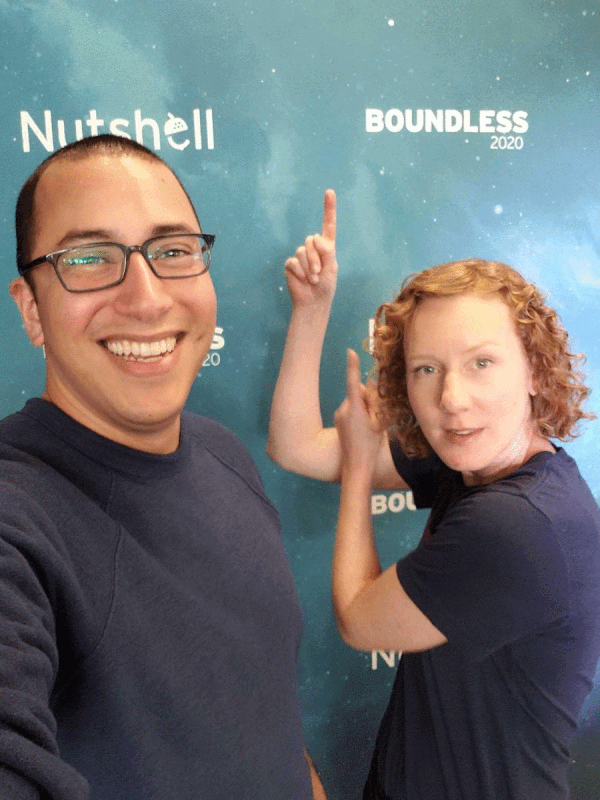
BEN GOLDSTEIN: I just saw that Outreach’s Unleash 2020 conference is moving forward as a free virtual event, and other major SaaS brands like Drift are doing the same for their own marquee events that got scrapped due to COVID-19. Eventually our world will return to normal, but I think this crisis will inspire a lot of companies to go virtual-first going forward. Brands want to make a big statement with their conferences, and you still can do that when it’s virtual. I think BOUNDLESS has proven that.
I understand the appeal of a packed conference hall full of people absorbing the excitement of your brand, but I can tell you from personal experience that the ROI on virtual events is wonderful, and there’s so much less risk and expense involved. As for the attendee experience, sitting in front of your computer might not be as fun as being there in person, but on the other hand, “watch from anywhere without paying a dime” is a pretty attractive offer.
Looking to produce a virtual event for your own company? Here are a few things you’ll absolutely need to lock down.
Deciding who should help organize your virtual event comes down to a fairly simple question: Which members of your team are actually excited about doing it? It helps if your core team members have a diverse skill-set, as you’ll need writers, designers, talent-wranglers, schedule-wranglers, and at least one person who’s comfortable in front of the camera.
Nutshell’s BOUNDLESS events have relied on close collaboration between our marketing team and our support team, which ensures that the event fulfills the twin goals of attracting potential customers and giving existing customers a truly valuable experience. But we always end up leaning on other Nutshellers throughout the process, especially for day-of tasks like running the live chat and making sure that the core team eats at some point.
Your virtual event has to be about something, and a unifying theme provides coherence and a promotional hook.
For BOUNDLESS 2020, we wanted the content to focus on how to create exceptional customer experiences that make your brand stand out among your competition. Our “Above and Beyond” theme gave us a north star that we could always follow, and helped us convey the event’s purpose during conversations with potential speakers and sponsors.
You’re not just looking for compelling speakers who will inspire your audience; those speakers also have to fit in with your overall brand identity. Is your brand fun and energetic? Is it casual and relatable? Does your brand speak or does it shout?
If your speakers drift too far away from the brand identity that your company has worked so hard to establish, your audience could be left confused or disappointed.
This is one of those must-haves that’s so obvious you might overlook it. If you plan to broadcast an all-day webstream out of your office or an event space, you can’t risk running it off of some shared Wi-Fi network that could go down without warning. A fast, hard-wired internet connection is an absolute necessity.
As we mentioned in the main article, we leaned on free swag and giveaways to incentivize registration for our first BOUNDLESS event in 2019, but switched to content incentives for 2020. With one event under our belts, we felt like we no longer had to bribe attendees with “stuff.”
If you’re organizing your very first virtual event, consider offering something extra beyond the speaker sessions. It could be private access to the speakers’ slide decks or presentation transcripts, or it could be an exclusive discount on your product or service. To capture the networking potential of an in-person event, you could set up a private Facebook or LinkedIn group that’s just for attendees.
The point is, your registrants should feel like they’re getting value even before the show takes place.
When it comes to broadcast quality, you get what you pay for. In 2019, we broadcast BOUNDLESS from a webcam balanced on a pile of books, with no outside help, and it looked like this. In 2020, we hired a professional event production team, and the event looked like this.
That difference in quality cost us about $9,000—not cheap, but absolutely worth it in our quest to look “legit.” (And yes, get a teleprompter if at all possible.)
Promoting the event to your own email list and social channels is a great start, but one of the primary goals of hosting a virtual event is to earn the email addresses of viewers who have never encountered your brand before, so you can market to them afterward. So, where can you find total strangers that might be willing to attend your event?
For BOUNDLESS 2020, we had a lot of success promoting the event in third-party newsletters that spoke to our target buyer—B2B sales professionals. We also got our opening keynote speaker to commit to promoting the event to his own sizable audience, and we paid for our hype video to appear in YouTube pre-roll ads.
By using these methods, we far exceeded our registration goal and the majority of our attendees were brand-new contacts. It’s also worth adding that our promotional efforts for BOUNDLESS 2020 lasted about ten weeks. Build a functional registration page as far in advance as you can, and give yourself at least two months to drive traffic to it.
You have to expect that things will go wrong in a live broadcast, so make sure your event plan doesn’t just cover the best-case scenario. What will you do if a marquee speaker has technical difficulties, or a key member of your production team suddenly falls ill and can’t make it in?
BOUNDLESS 2019 taught us a lot about what could go wrong during a virtual event, and those lessons strongly informed the production of BOUNDLESS 2020. Most notably, the decision to have pre-recorded sessions on standby was a life-saver when a speaker dropped out on the day of the show.
We also did our best to ensure that any team member’s job could be covered in the event of an emergency. If our emcee couldn’t make it in, any one of us could follow the script that was already loaded into the teleprompter. If our speaker coordinator went missing, the list of contact information for every speaker was shared among the team so that we could still wrangle them through the day.
Is your senior leadership okay with you spending $20,000+ of the company’s money putting this thing together? Are your co-workers and managers okay with the fact that every member of the event-planning team will have a reduced capacity for months in the lead-up to the event? These are things you’ll need to figure out almost before anything else.
You can help this buy-in process by 1) developing a clear argument for the impact of your virtual event on brand awareness and revenue, and 2) including as many members of the team as possible in event production. When everyone has a role in the event—even a small one—they’ll be more invested in its success.
The value you get from hosting your virtual event shouldn’t end the moment the cameras turn off. Assuming you record the broadcast (hint, hint), you should use those recordings as marketing assets across as many of your channels as possible.
In the two weeks following BOUNDLESS 2020, we…
Think about how you can squeeze the most value out of your virtual event sessions after the fact. Who else do you want to see this content, and how will you deliver it to them?
Planning a virtual event takes a lot of time and energy, and dealing with the unexpected setbacks and general anxiety of event planning can be emotionally exhausting work. Both of our BOUNDLESS events were immediately followed by afterparties so that our team could celebrate what we accomplished. Some of us even took some time off to recharge after the months of sustained effort.
Encourage your team to do whatever they feel is necessary to celebrate, rest, and recover after your virtual event. After all, they’ll have to start planning the next one before you know it…

No problem. To see if Nutshell is the right choice for your sales team, start a 14-day free trial today!

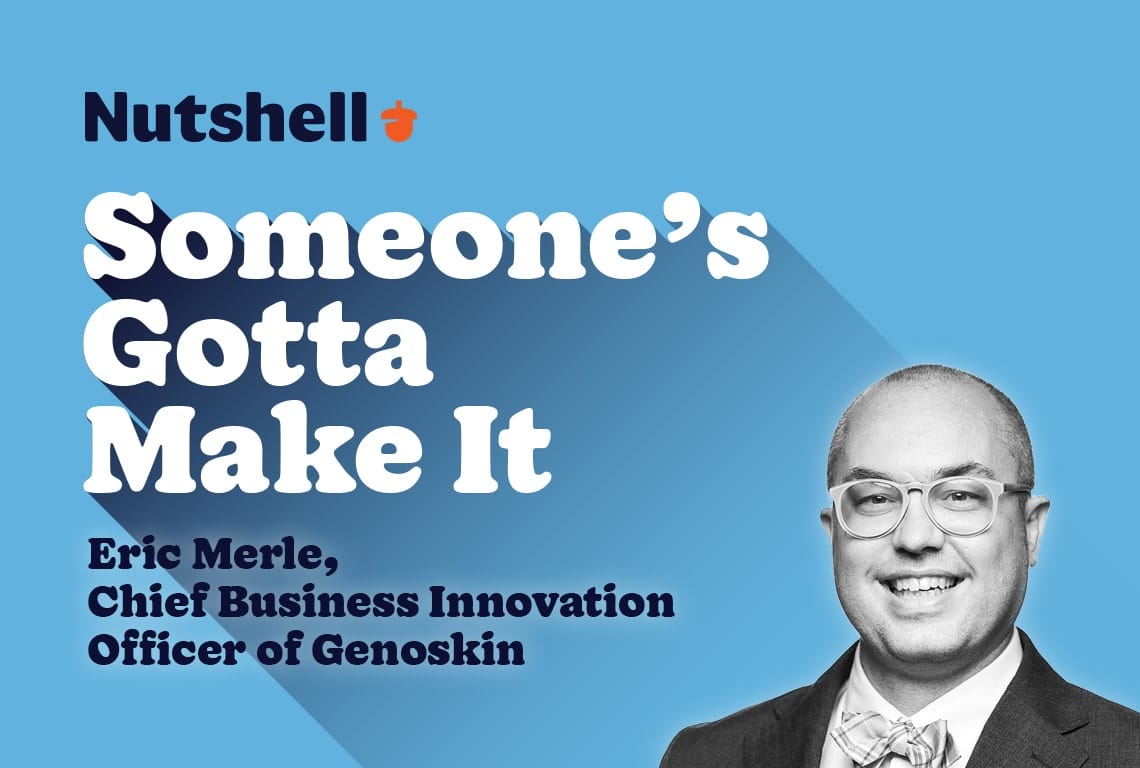
Join 30,000+ other sales and marketing professionals. Subscribe to our Sell to Win newsletter!
 Email & Calendar Sync
Email & Calendar Sync
Use our calculator to add up your total investment of CRM and Add-ons
VIEW ALL PRICING
 Product Info
Product Info Education & Guides
Education & Guides Company
Company